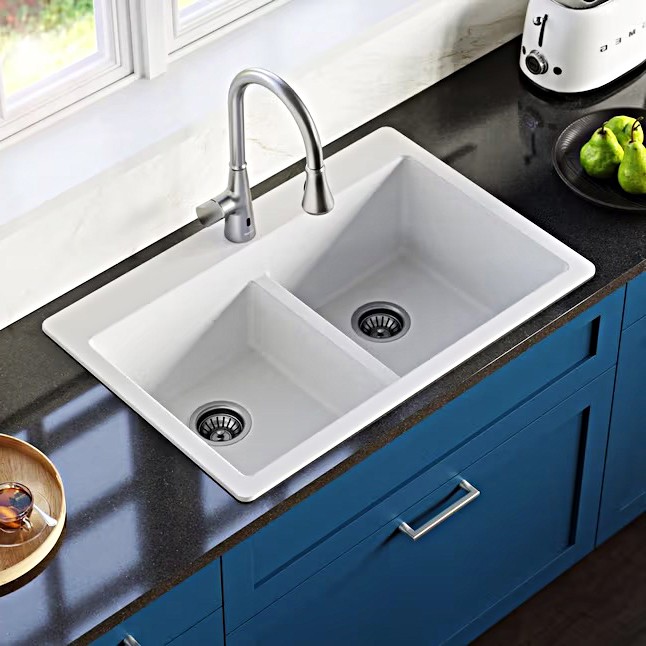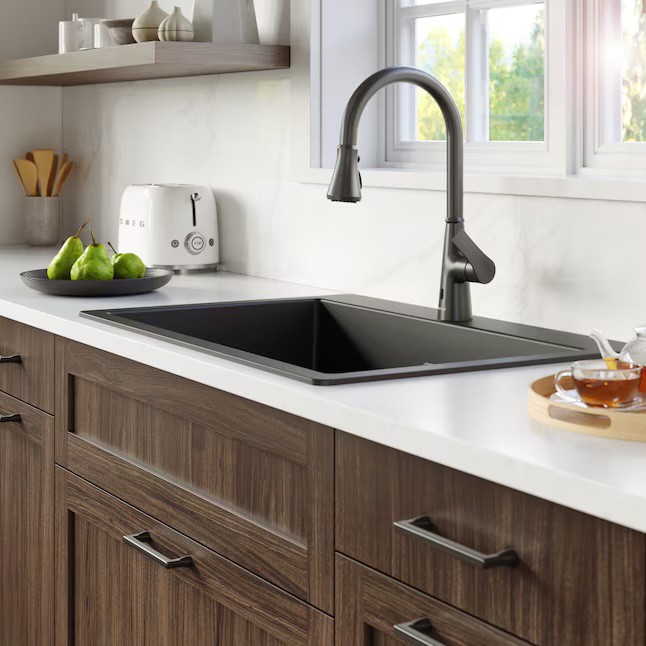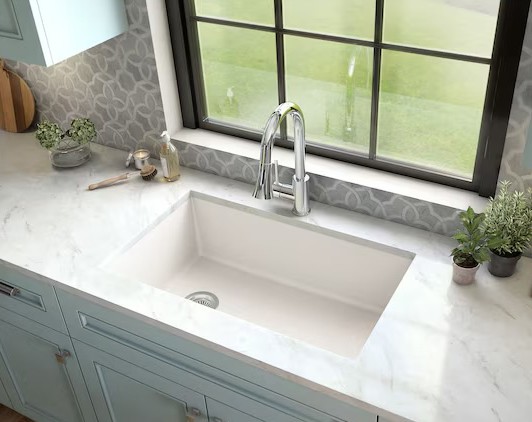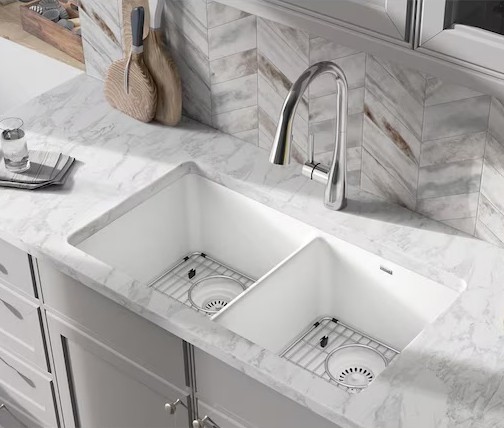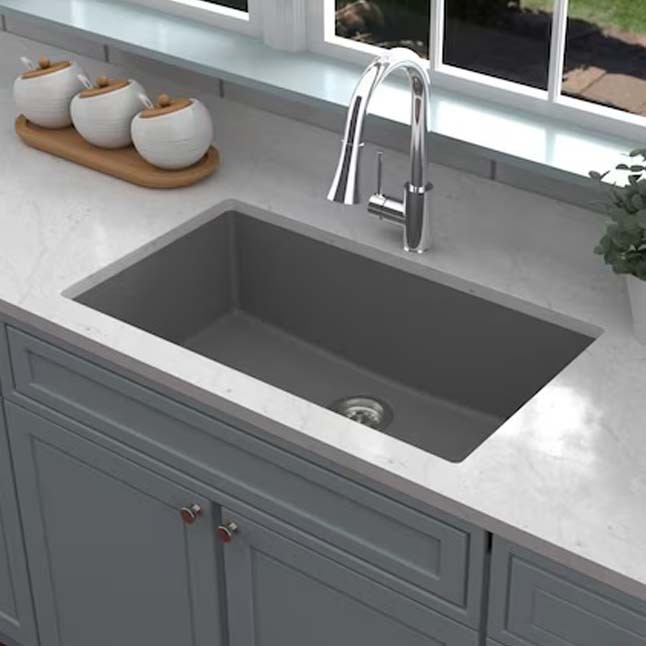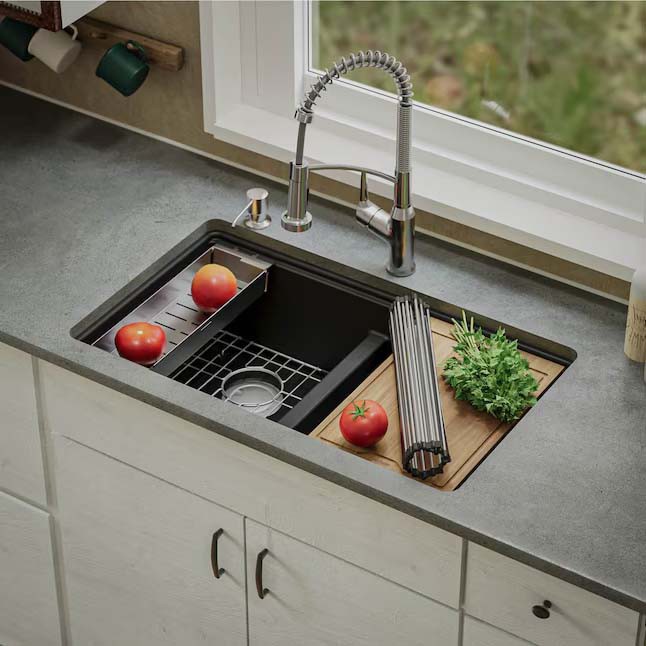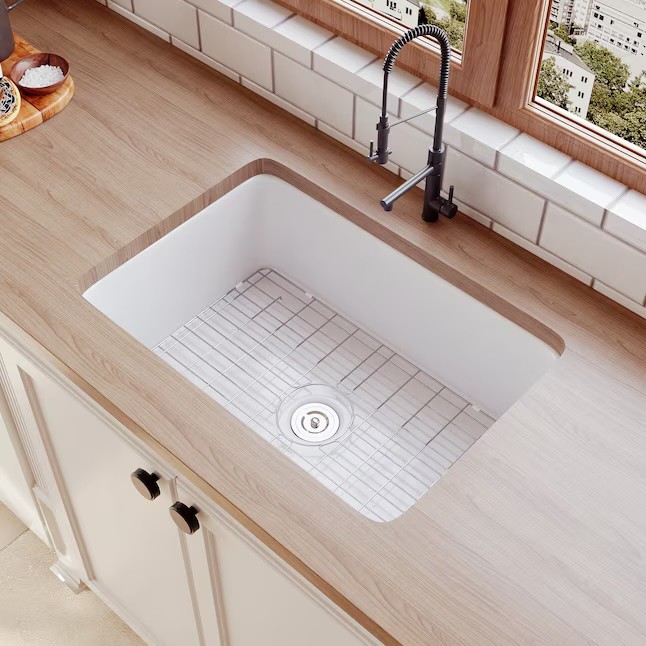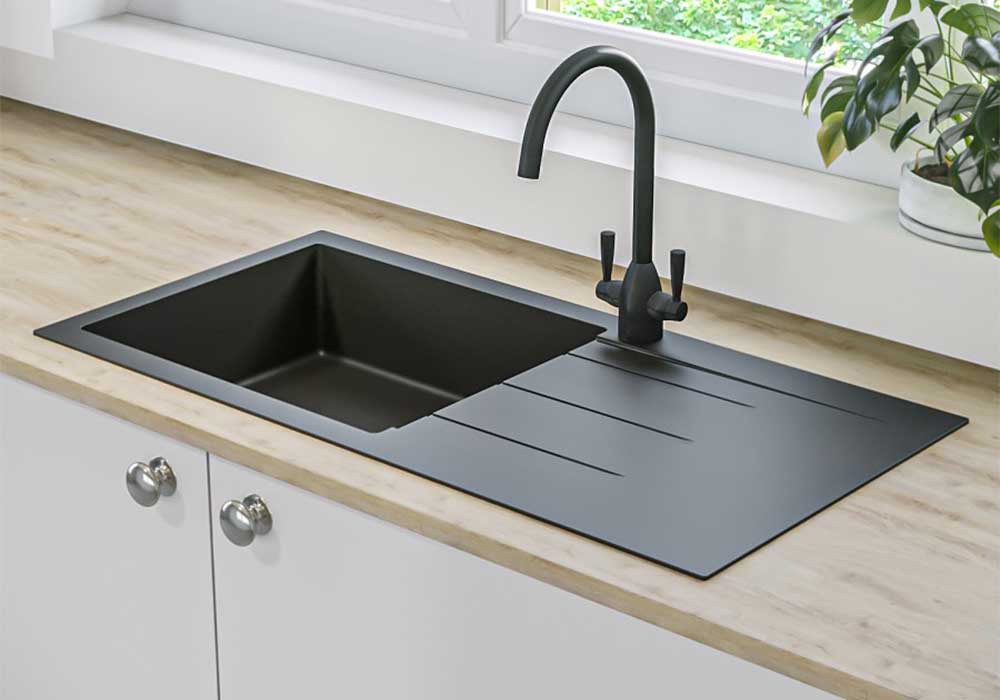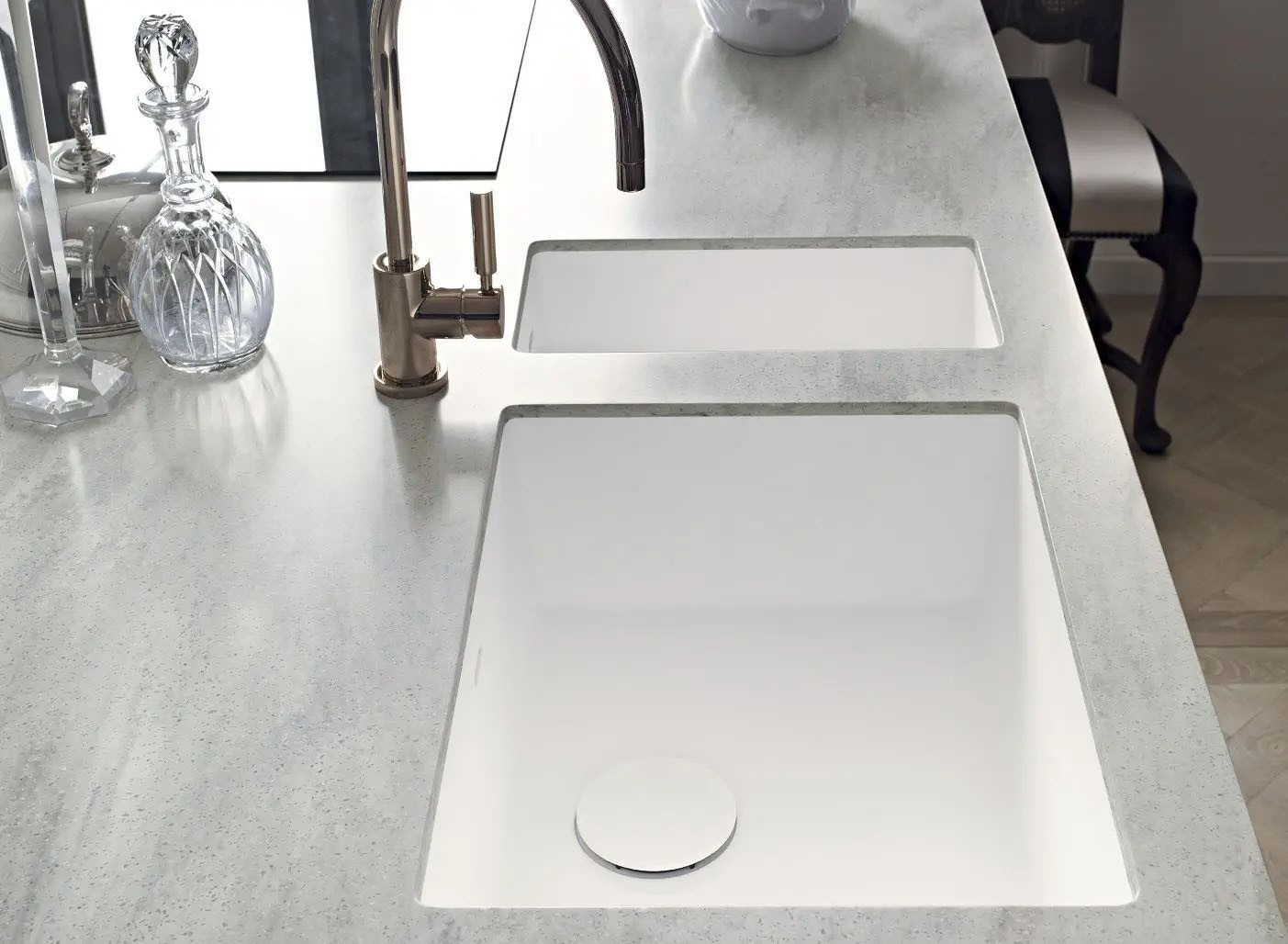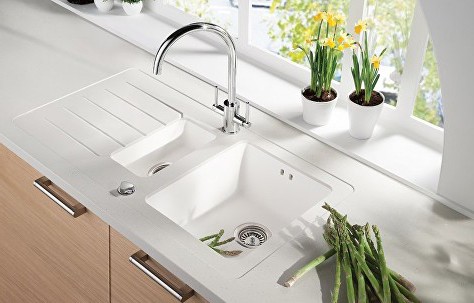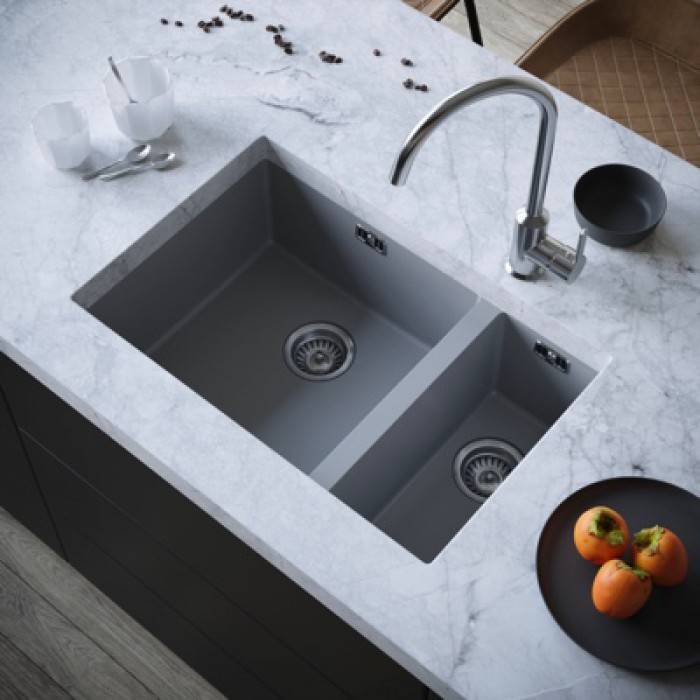Maryfass Kitchen Quartz Sinks Manufacturer in Turkiye
What is a Quartz Sink and What is it Made From?
-
Composition: Quartz sinks are engineered products made from:
-
Natural Quartz: Ground quartz crystals, a hard and abundant mineral (silicon and oxygen), make up the bulk of the material, providing strength and a stone-like appearance.
-
Resins: Acrylic or polyester resins (10–20%) bind the quartz particles, creating a smooth, non-porous surface.
-
Pigments: Added for color consistency and aesthetic variety.
-
-
Manufacturing Process: The quartz, resin, and pigments are mixed, molded under high pressure, and cured to form a dense, solid sink. This process ensures uniformity and eliminates the natural imperfections found in stone.
Advantages of Quartz Sinks
-
Durability: Quartz composite is exceptionally strong, resisting scratches, chips, and dents better than many natural stones. It withstands daily wear and tear in busy kitchens.
-
Non-Porous Surface: Unlike natural stone, quartz sinks are non-porous, preventing absorption of liquids, stains, or odors. This makes them hygienic, resistant to bacteria, mold, and mildew.
-
Heat Resistance: Quartz sinks can tolerate temperatures up to 535°F (280°C), suitable for handling hot pots, though extreme heat (e.g., straight-from-oven pans) may damage the resin.
-
Low Maintenance: They don’t require sealing, unlike granite or natural stone sinks, and are easy to clean with mild soap and water.
-
Aesthetic Versatility: Available in a range of colors and matte finishes, quartz sinks can complement various kitchen or bathroom designs.
-
Sound Dampening: The dense material reduces noise from running water, clanging dishes, or garbage disposals, making them quieter than stainless steel sinks.
-
Affordability: Quartz sinks ($300–$600) are more cost-effective than natural stone sinks ($1,000+) and often cheaper than high-end stainless steel or fireclay models.
-
Environmentally Friendly: Quartz composite often uses waste quartz from quarrying, and some manufacturers use bio-based resins, reducing environmental impact.
Durability
-
Strength: Quartz sinks are highly durable due to their dense, engineered structure. They resist scratches, stains, chips, and cracks better than natural stone, porcelain, or acrylic sinks.
-
Impact Resistance: While tough, quartz sinks are unforgiving to fragile items like glassware or china, which may break upon impact due to the sink’s hardness.
-
Longevity: With proper care, quartz sinks can last decades, maintaining their appearance without fading or significant wear.
-
Limitations:
-
Darker colors may show scratches or scuffs more visibly.
-
Repeated heavy impacts or extreme heat could potentially crack the sink, though this is rare.
-
Installation challenges due to weight may require professional handling to avoid damage.
-
Where Are Quartz Sinks Used?
Quartz sinks are versatile and used in:
-
Kitchens: Ideal for busy households due to their durability, stain resistance, and ease of cleaning. They handle heavy cookware, frequent washing, and food prep.
-
Bathrooms: Used in vanities for their stylish appearance and low maintenance, especially in high-end or modern designs.
-
Laundry Rooms: Suitable for utility sinks due to their resistance to chemicals and heavy use.
-
Commercial Spaces: Found in restaurants, hotels, or offices where hygiene and durability are priorities.
-
Configurations: Available as single-bowl, double-bowl, undermount, top-mount, or integrated (seamless with quartz countertops) sinks, catering to various needs like dish soaking or prep work.
Projects Using Quartz Sinks
-
Residential Kitchen Remodels: Popular in modern, farmhouse, or minimalist kitchen designs for their sleek, seamless look, especially when paired with quartz countertops.
-
Bathroom Renovations: Used in luxury or contemporary bathrooms for a cohesive aesthetic with quartz vanities.
-
Multi-Unit Developments: Developers choose quartz sinks for apartments or condos due to their durability, low maintenance, and cost-effectiveness compared to natural stone.
-
Commercial Projects: Installed in high-traffic settings like boutique hotels or upscale restaurants for their hygienic properties and stylish matte finishes.
-
Specific Examples: Brands like Elkay, Karran, and Hafele offer quartz sinks (e.g., Elkay Quartz Classic, Hafele’s 20-year warranty models) used in custom home projects and renovations showcased on sites like QualityBath.com or KitchenMagic.com.
Colors Available
Quartz sinks come in a variety of solid, non-fading colors due to the addition of pigments during manufacturing. Common options include:
-
Neutral Tones: White, black (onyx), gray, beige, sand, and brown for versatile pairing with countertops.
-
Bold Colors: Some manufacturers offer vibrant hues like red or blue, though these are less common.
-
Matte Finishes: Quartz sinks are typically matte, lacking the glossy sheen of cast iron or polished granite. Patterns mimicking natural stone are limited due to the engineered nature of the material.
-
Customization: Integrated sinks can be color-matched to quartz countertops for a seamless look.
Comparison to Other Sink Materials: Benefits of Quartz
Here’s how quartz sinks compare to other common sink materials, highlighting their benefits:
-
Stainless Steel
-
Quartz Benefits:
-
Wider color variety (stainless steel is limited to silver).
-
Superior sound dampening for quieter operation.
-
More luxurious, stone-like aesthetic for modern or high-end kitchens.
-
Non-porous, reducing bacteria buildup compared to some stainless steel grades.
-
-
Drawbacks: Quartz sinks are heavier, more expensive ($300–$600 vs. $100–$500 for stainless steel), and less forgiving to dropped dishes.
-
Stainless Steel Advantages: Lighter, easier to install, rust-resistant, and often more affordable.
-
-
Granite Composite
-
Quartz Benefits:
-
Non-porous, requiring no sealing (granite composite may need occasional sealing, though less than natural granite).
-
Slightly more affordable than granite composite in some cases ($300–$600 vs. $250–$700).
-
Smoother surface, easier to clean.
-
-
Drawbacks: Granite composite is often tougher, with even higher scratch and chip resistance.
-
Granite Composite Advantages: Similar aesthetics but potentially more durable; available in uniform matte finishes.
-
-
Natural Granite
-
Quartz Benefits:
-
More affordable ($300–$600 vs. $1,000+ for natural granite).
-
Non-porous, eliminating the need for sealing and reducing staining risks (natural granite is porous and absorbs spills).
-
Consistent color options (natural granite has variable patterns).
-
-
Drawbacks: Lacks the unique veining and gloss of natural granite.
-
Natural Granite Advantages: Authentic stone look with natural patterns, though higher maintenance.
-
-
Fireclay/Ceramic
-
Quartz Benefits:
-
More resistant to scratches and stains (fireclay can chip or stain).
-
Quieter due to sound dampening.
-
Wider color range beyond white or biscuit tones common in fireclay.
-
-
Drawbacks: Fireclay has a classic, farmhouse aesthetic that quartz can’t replicate.
-
Fireclay Advantages: Delicate appearance, mega-durable if not chipped, and easier to clean for some users.
-
-
Cast Iron (Enameled)
-
Quartz Benefits:
-
Non-porous, reducing bacteria and stain risks (enamel can chip, exposing iron to rust).
-
No need for frequent cleaning or protective grids.
-
More modern matte finish options.
-
-
Drawbacks: Cast iron is heavier and may require cabinet reinforcement, similar to quartz.
-
Cast Iron Advantages: Timeless glossy finish and high resistance to scratches when intact.
-
-
Acrylic/Solid Surface
-
Quartz Benefits:
-
Far more durable and heat-resistant (acrylic scratches easily and melts under high heat).
-
Harder surface, less prone to dents or stains.
-
Stone-like aesthetic vs. plastic-like look of acrylic.
-
-
Drawbacks: Acrylic can be seamlessly integrated with countertops and repaired if scratched.
-
Acrylic Advantages: Lightweight, cheaper, and available in more shapes.
-
Why Choose Quartz Sinks? (Necessity)
Quartz sinks aren’t a must for every project, but they are a compelling choice for specific needs and preferences. Here’s why they might be necessary or highly beneficial:
-
Hygiene and Safety: The non-porous surface is ideal for families, busy kitchens, or commercial spaces where cleanliness is critical, as it prevents bacteria, mold, and odor retention.
-
Low Maintenance: For homeowners or property managers seeking a sink that doesn’t require sealing, frequent cleaning, or special care, quartz is a practical choice, saving time and money.
-
Aesthetic Cohesion: In modern or luxury designs, quartz sinks pair seamlessly with quartz countertops, creating a sleek, uniform look that elevates the space’s value and appeal.
-
Durability for Heavy Use: In high-traffic environments (e.g., large households, rentals, or restaurants), quartz sinks withstand rough handling, heavy cookware, and frequent cleaning without showing wear.
-
Cost-Effective Luxury: Quartz offers the look and feel of natural stone at a fraction of the cost, making it ideal for budget-conscious renovations aiming for a high-end aesthetic.
-
Noise Reduction: For open-plan homes or quiet environments, the sound-dampening properties enhance user experience, especially compared to noisy stainless steel sinks.
When Quartz Might Not Be Necessary:
-
If you prefer the glossy finish or natural veining of cast iron or granite, quartz’s matte, uniform look may not suit your taste.
-
Budget-conscious projects might opt for stainless steel or acrylic for lower upfront costs, though long-term maintenance may offset savings.
-
In rustic or farmhouse-style kitchens, fireclay or ceramic sinks may better match the aesthetic.
Critical Perspective
While quartz sinks are marketed as a premium, durable option, it’s worth questioning the hype:
-
Overstated Durability? Manufacturers emphasize quartz’s toughness, but the resin component can be damaged by extreme heat or harsh chemicals, and the hardness can break delicate dishes. This suggests quartz isn’t invincible, and user habits matter.
-
Environmental Claims: The “green” label (using waste quartz) is appealing, but resin production and energy-intensive manufacturing processes raise questions about true sustainability. Natural stone, while more expensive, might have a lower processing footprint.
-
Cost vs. Value: Quartz is cheaper than natural stone but pricier than stainless steel or acrylic. For budget projects, stainless steel might offer similar durability with less risk of dish breakage.
-
Aesthetic Trade-Offs: The lack of glossy finishes or natural stone patterns limits quartz’s appeal for those seeking unique, high-shine designs.
Ultimately, the necessity of a quartz sink depends on your priorities: hygiene, low maintenance, and a modern aesthetic make it a strong contender, but other materials may better suit specific styles or budgets.
Conclusion
Quartz sinks, made from a blend of quartz and resin, offer a durable, non-porous, and stylish alternative to traditional sink materials. Their advantages include hygiene, low maintenance, heat resistance, and aesthetic versatility, making them ideal for kitchens, bathrooms, and commercial spaces. They shine in modern remodels, luxury homes, or high-traffic environments, with colors ranging from white and black to bold hues. Compared to stainless steel, granite, fireclay, or acrylic, quartz balances cost, durability, and style, though it’s not perfect for every project due to its weight, matte-only finishes, and potential for dish breakage. Choose quartz if hygiene, ease of care, and a stone-like look are priorities, but weigh your design goals and budget against other materials for the best fit.


